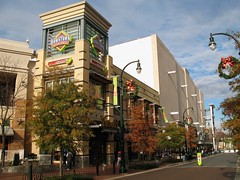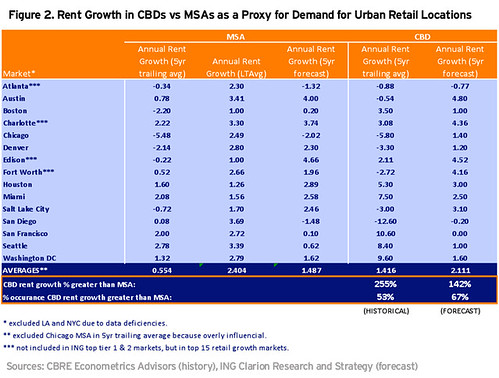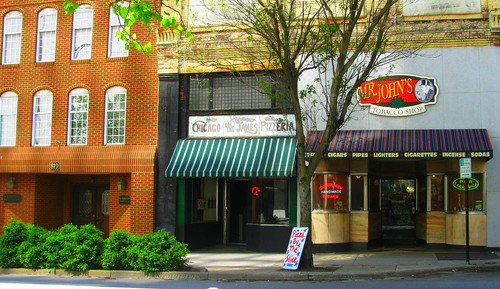Industry analysis says future is brighter for urban retail than for suburban

Posted April 13, 2011 at 1:31PM
In an analysis posted on the National Real Estate Investor web site, David Lynn concludes that patterns of land use in the US are taking a “significant turn” from the past pattern of suburban dominance, and that the implications are significant for the future of retail. Given the new – and likely to be lasting – trend – favoring cities and traditional town centers, “investors will . . . need to reformulate retail strategies, given changing patterns of demand and land use.” Lynn is managing director and head of investment strategy for ING Clarion Partners in New York.
Lynn’s firm examined retail rent trends in US metropolitan areas, comparing in each area the rate of change in rents for the overall region to those of the central business district:
“The results indicate that 53 percent of the time in the last five years, the rent growth for retail assets in the CBD has outpaced the overall MSA rent growth. The magnitude of average rent growth has been about 2.5 times greater in the CBD than in the MSA. For the five-year forecast, the CBD rent growth outpaces the MSA 67 percent of the time, and is on average 1.5 times greater in magnitude.
“This projection suggests that more often than not the demand for — and lack of supply of — retail space in CBDs will exhibit significantly more robust rent growth than less dense areas of the greater MSA encompassing that CBD . . . The results of this data analysis indicate a potential business preference for denser urban locations over outer edges of the MSA. Given our analysis of demographic and land use trends, we expect this divergence to continue and potentially widen in the future.”
A continuing growth in demand for urban neighborhoods, says Lynn, will be shaped by both retiring Baby Boomers and emerging “Echo Boomers” (also sometimes called “Millennials” or “Generation Y”), the two largest generations in US history. Both are showing a preference for mixed-use, walkable communities over single-use, automobile-dependent subdivisions. In particular, as Baby Boomers retire, Lynn says that “we expect at most they will exhibit a relatively insignificant urban outmigration from cities“ that will be more than offset by urban influx from the Echo Boomers.
“Baby boomers” generally refers to people born in the years of the “baby boom” following the second world war, roughly from 1946 through the early 1960s. During that period the US birth rate was substantially higher (per capita) than at any time since the 1920s, when the population was smaller.  Baby Boomers are said to control over 80 percent of the country's personal financial assets and more than 50 percent of its discretionary spending power. They are responsible for more than half of all consumer spending, buy 77 percent of all prescription drugs, 61percent of over-the-counter medication and 80 percent of all leisure travel. Those are not insignificant numbers for retailers to consider.
Baby Boomers are said to control over 80 percent of the country's personal financial assets and more than 50 percent of its discretionary spending power. They are responsible for more than half of all consumer spending, buy 77 percent of all prescription drugs, 61percent of over-the-counter medication and 80 percent of all leisure travel. Those are not insignificant numbers for retailers to consider.
As they near retirement, their lifestyle preference will be increasingly urban, according to Lynn:
“Baby Boomers have indicated in analyses that they are most concerned with obtaining affordable housing. They will also want to be in communities that are walkable or have public transit for both philosophical and physical reasons.
“It is likely they will prefer and eventually have to stop driving. For this reason, it is likely they will seek smaller, easier shopping formats that are closer to home . . . For these reasons, we believe the Baby Boomers will either be inclined to move to or remain in urban areas. Also in the near term, they are unlikely to retire at typical retirement age.”
Echo Boomers refers to the generation born mostly from the early 1980s through the late 1990s, when there was also a rise in the birth rate. Many are the children of Baby Boomers. The Echo Boomers are known to seek interaction and the liveliness of urban environments. Lynn says that, “from 1990 to 2000, the Echo Boomers showed a 250% increase in positive likelihood to live within three miles of a central business district.”
Additional factors driving the trend back to cities and urban environments are rising transportation costs, favoring shorter commutes and a shift to environments that support walking and public transportation. Lynn also credits smart growth and new urbanist planning theory that has led jurisdictions to eschew the problems stemming from suburban sprawl in favor of walkable neighborhoods.
For Lynn’s analysis, go here.
Move your cursor over the images for credit information.


